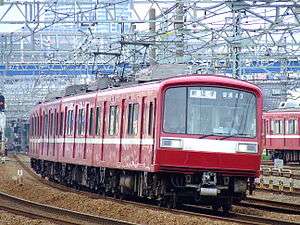Keikyu 2000 series
| Keikyu 2000 series | |
|---|---|
 A 4-car set in July 2007 | |
| In service | December 1982–2018 |
| Manufacturer | Tokyu Car Corporation, Kawasaki Heavy Industries |
| Replaced | 600 series |
| Refurbishment | 1998 |
| Scrapped | 2012–2018 |
| Number built | 72 vehicles (12 sets) |
| Number in service | None |
| Number scrapped | 36 vehicles (7 sets) |
| Formation | 4/8 cars per trainset |
| Operator(s) | Keikyu |
| Specifications | |
| Car body construction | Steel |
| Maximum speed | 120 km/h (75 mph) |
| Traction system | Chopper control |
| Electric system(s) | 1,500 V DC |
| Current collection method | overhead wire |
| Track gauge | 1,435 mm (4 ft 8 1⁄2 in) |
The Keikyu 2000 series (京急2000形) was an electric multiple unit (EMU) train type operated by the private railway operator Keikyu on commuter services in the Tokyo area of Japan since 1982. Originally introduced to replace the earlier 600 series sets on limited-stop Limited Express (快特 Kaitoku) services, from 1998, they were rebuilt with an additional pair of doors per side and longitudinal seating for reassignment to regular commuter services.[1]
Formations
As of 1 April 2016, the fleet consisted of five eight-car sets and one four-car set (classified 2400 series).[2] The last remaining four-car set was withdrawn from service in October 2016.[3]
8-car sets
The eight-car sets are formed as follows, with six motored (M) cars and two trailer (T) cars.[2]
| Designation | M1c | M2 | M3 | Tu | Ts | M1 | M2 | M3c |
|---|---|---|---|---|---|---|---|---|
| Numbering | 20x1 | 20x2 | 20x3 | 20x4 | 20x5 | 20x6 | 20x7 | 20x8 |
- The "x" in the car numbers corresponds to the set number.
- The two "M2" cars are each fitted with two lozenge-type pantographs.[2]
4-car sets
The four-car sets were formed as follows, with three motored (M) cars and one trailer (T) car.[2]
| Designation | M1c | M2 | T | M3c |
|---|---|---|---|---|
| Numbering | 24x1 | 24x2 | 24x3 | 24x4 |
- The "x" in the car numbers corresponded to the set number.
- The "M2" cars were fitted with two lozenge-type pantographs.[2]
Liveries
When delivered, the sets were initially painted in vermillion red with white around the side windows. From 1998, when converted to regular commuter use, they were repainted into all-over vermillion red with a white bodyside stripe.[1]
From January 2013, set 2011 was repainted into the original livery of vermillion with white window surrounds to mark the 30th anniversary of the 2000 series. It remained in this livery for approximately two years.[4]
 Original livery in August 2000
Original livery in August 2000 "Mirai" promotional livery in May 1988
"Mirai" promotional livery in May 1988 Later commuter style livery in July 2006
Later commuter style livery in July 2006 Set 2011 repainted into its original style livery in February 2013
Set 2011 repainted into its original style livery in February 2013
Interior
 Original 2-door configuration with transverse seating in August 2000
Original 2-door configuration with transverse seating in August 2000- Later 3-door commuter configuration with longitudinal seating in September 2010
History
The 2000 series was awarded the 1983 Blue Ribbon Award, presented annually by the Japan Railfan Club for the most outstanding train design of the year.[5]
Withdrawal
Withdrawals commenced in 2012, with three of the four-car sets withdrawn in May 2012. Two more four-car sets were withdrawn in March 2016, leaving just set 2451 in service, until it was withdrawn following its last day in service on 11 October 2016.[3]
In 2018, the remaining 2000 series began to be withdrawn, with the last set, set 2011, making its final run on 29 March 2018.
References
- 1 2 私鉄車両年鑑 2012: 大手15社営業用車両完全網羅 私鉄車両年鑑2012 [Japan Private Railways Annual 2012]. Tokyo, Japan: Ikaros Publications Ltd. February 2012. p. 125. ISBN 978-4-86320-549-9.
- 1 2 3 4 5 私鉄車両編成表 2016 [Private Railway Rolling Stock Formations - 2016] (in Japanese). Japan: Kotsu Shimbunsha. 25 July 2016. p. 35. ISBN 978-4-330-70116-5.
- 1 2 京急2000形の4両編成が営業運転を終了 [Keikyu 2000 series 4-car sets retired]. Japan Railfan Magazine Online (in Japanese). Japan: Koyusha Co., Ltd. 12 October 2016. Archived from the original on 13 October 2016. Retrieved 13 October 2016.
- ↑ 京急2000形1編成 登場時の塗装に [Keikyu 2000 series set 1 to be repainted into original livery]. Tetsudo.com (in Japanese). Japan: Asahi Interactive Inc. 17 January 2013. Retrieved 17 January 2013.
- ↑ ブルーリボン賞・ローレル賞 選定車両一覧 [Blue Ribbon Award & Laurel Prize Winner List] (in Japanese). Japan: Japan Railfan Club. May 2012. Archived from the original on 26 October 2010. Retrieved 18 January 2013.
External links
| Wikimedia Commons has media related to Keikyu 2000 series. |
- Keikyu 2000 series official information (in Japanese)
